

S 



 Pd+
Pd+
Z 

II.2.4 Pd(0) and Pd(II) Complexes
Containing Sulfur and Selenium Ligands
KUNIO HIROI
A. INTRODUCTION
The reactivity of -allylpalladium complexes is dependent on the nature of the ligands coordinated to them. In general, strongly -accepting ligands such as phosphines generate highly reactive palladium complexes, whereas electron-donating ligands such as amines provide less reactive species.
Various types of chiral ligands incorporating organosulfur groups and other different donor atoms have been designed, in which only one of the donor atoms could behave as a-acceptor. So it should be desirable in asymmetric synthesis that a catalyst involving a chiral ligand enables one to discriminate two allyl termini, since a nucleophile would preferentially attack the allyl terminus trans to the better -acceptor. Therefore, it should be very useful for the prediction of the stereochemistry of the product in Pd-catalyzed asymmetric reactions with ligands to determine the order of preference of the electronic property for the-acceptor of various coordinatable elements, particularly sulfur atoms, in the ligands.
With chiral sulfoxides as ligands, there are two possibilities in the formation of chelates with palladium: chelates by coordination of sulfinyl sulfur and oxygen atoms (Scheme 1).
B. CHIRAL LIGANDS CONTAINING SULFENYL GROUPS
B.i. Oxazoline Ligands
Enantiomerically pure ligands containing a 4,5-dihydrooxazole moiety tethered to an auxiliary sulfur donor have been developed, providing enantioselectivities of 40 –96%[1] (Scheme 2).
The reaction of 1 with dimethyl sodiomalonate in THF at reflux in the presence of catalytic amounts of [Pd( -allyl)Cl]2 and the ligands 3,[2,3] 4,[4] and 5[4 – 6] afforded the substitution product (S)-2. The enantioselectivity is summarized in Table 1.
Use of 4,5-dihydrooxazoles 6a and 6b in the above reaction provided (R)-2 with 56% and 88% ee, respectively.[4]
Chiral phenylsulfenyl derivatives of ferrocenyl-oxazoline were used as chiral ligands in the Pd-catalyzed alkylation of 1. The highest ee (98%) of (R)-2 was obtained with 7 as a ligand[7] (Scheme 3).
Handbook of Organopalladium Chemistry for Organic Synthesis, Edited by Ei-ichi Negishi ISBN 0-471-31506-0 © 2002 John Wiley & Sons, Inc.
67
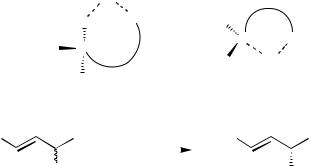
68 II |
PALLADIUM COMPOUNDS: STOICHIOMETRIC PREPARATION |
|
|||||
TABLE 1. Palladium-Catalyzed Asymmetric Alkylations of 1a |
|
|
|||||
|
|
|
|
|
|
|
|
|
|
|
|
|
|
|
ee (%) |
Ligand |
R1 |
R2 |
Solvent |
Pd:L |
Yield of 2 |
of (S)-2 |
|
3a |
Me |
Ph |
THF |
|
1:2 |
56 |
6 |
3b |
CH2Ph |
H |
THF |
|
1:2 |
68 |
24 |
3c |
Pri |
H |
THF |
|
1:10 |
89 |
81 |
3d |
Ph |
H |
THF |
|
1:2 |
Trace |
— |
3e |
But |
H |
THF |
|
1:2 |
Trace |
— |
3f |
CH2OH |
Ph |
THF |
|
1:2 |
65 |
5 |
3g |
CH2OCPh3 |
Ph |
THF |
|
1:2 |
Trace |
— |
4a |
Me |
Me |
THF |
|
1:2 |
68 |
51 |
4b |
CH2Ph |
Me |
THF |
|
1:2 |
56 |
40 |
4c |
Pri |
Me |
THF |
|
1:2 |
74 |
70 |
4d |
Ph |
Me |
THF |
|
1:2 |
67 |
60 |
4e |
But |
Me |
THF |
|
1:4 |
69 |
75 |
4f |
Pri |
Ph |
CH2Cl2 |
1:2 |
52 |
76 |
|
4g |
But |
Ph |
THF |
|
1:2 |
0 |
— |
5a |
Me |
Me |
THF |
|
1:2 |
91 |
40 |
5b |
CH2Ph |
Me |
THF |
|
1:2 |
90 |
52 |
5c |
Pri |
Me |
THF |
|
1:2 |
98 |
58 |
5d |
Ph |
Me |
THF |
|
1:2 |
84 |
66 |
5e |
But |
Me |
THF |
|
1:2 |
86 |
80 |
5f |
Pri |
Ph |
CH2Cl2 |
1:2 |
96 |
90 |
|
5g |
But |
Ph |
CH CL |
2 |
1:2 |
92 |
96 |
|
|
|
2 |
|
|
|
|
a The reactions of 1 with dimethyl sodiomalonate were carried out in the presence of a catalytic amount of [Pd( -allyl)Cl]2 and ligands 3–5.
+
|
|
Pd |
|
|
|
|
|
O |
|
Z |
|
O |
|
|
|
|
|
|
||
Ar |
S |
|
|
|
S |
Z |
|
|
|
|
+ |
||
|
|
|
|
|
Ar |
Pd |
|
: |
|
|
|
|
|
|
|
|
|
Scheme 1 |
|
|
Ph |
Ph |
|
|
|
Ph |
Ph |
OAc |
|
|
|
|
|
CH(CO2Me)2 |
|
|
|
|
|
||
|
|
|
|
|
|
|
1 |
|
|
|
|
|
(S)-2 |
|
|
|
|
Scheme 2 |
|
|
The thiophene ligand as an electron-rich -system acts as a donor and, as a result of the trans effect, should transfer electron density to the allylic carbon atom trans to the sulfur atom. The carbon atom should less willingly undergo nucleophilic attack because of the increased electron density. Thus, the favorable attack occurs by route A to give (S)-2[2,3] (Scheme 4).
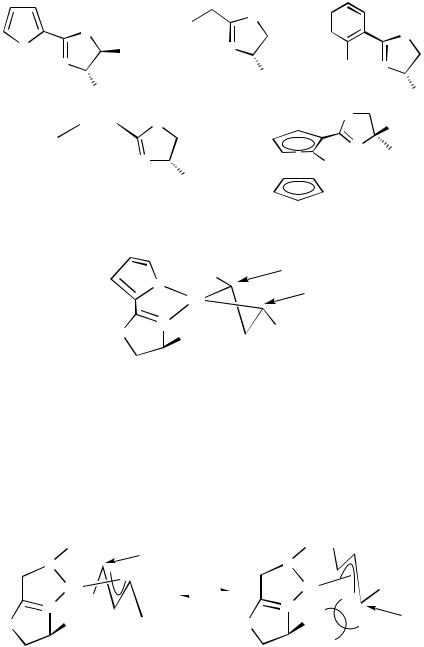
II.2.4 Pd(0) AND Pd(II) COMPLEXES CONTAINING SULFUR AND SELENIUM LIGANDS |
69 |
||||||||||||||
|
O |
|
|
R2S |
O |
|
|
|
|
|
|
|
|
O |
|
|
|
|
|
|
|
|
|
|
|
|
|
||||
|
|
|
|
|
|
|
|
|
|
|
|
|
|||
S |
R2 |
|
|
N |
|
|
|
|
|
|
|
|
|
||
|
|
|
|
|
|
|
|
|
|
|
|
|
|||
N |
|
|
|
|
R1 |
|
|
|
|
R2S |
N |
|
|
||
|
|
|
|
|
|
|
|
|
|
|
|
|
|
|
|
3a−g |
R1 |
|
|
|
4a−g |
|
|
|
|
|
|
|
5a−g |
R1 |
|
|
(CH2)n |
|
O |
|
|
|
|
|
|
|
O |
|
H |
|
|
|
|
|
|
|
|
|
|
|
|
|
|
|
|||
MeS |
|
N |
|
|
|
|
|
|
|
|
|
N |
|
t-Bu |
|
|
|
|
|
|
|
|
|
|
|
|
|
||||
|
|
|
|
|
|
|
|
|
|
|
|
|
|||
|
|
|
|
|
|
|
|
|
S |
|
Ph |
|
|
|
|
|
|
|
Ph |
|
Fe |
|
|
|
|||||||
|
|
|
|
|
|
|
|
||||||||
|
|
|
|
|
|
|
|
|
|
|
|||||
|
6a |
n = 1 |
|
|
|
|
|
|
|
|
|
|
|
|
|
|
|
|
|
|
|
|
|
|
|
|
|
|
|||
|
|
|
|
|
|
|
|
|
|
|
|
|
|||
|
|
|
|
|
|
|
|
|
|
|
|
|
|
||
|
b |
= 2 |
|
|
|
|
|
|
|
7 |
|
|
|
||
|
|
|
|
Scheme 3 |
|
|
|
|
|
|
|
|
|
|
|
|
|
|
|
Ph |
|
A |
|
|
|
|
|
|
|||
|
|
|
S |
|
|
|
|
|
|
|
|
|
|
|
|
|
|
|
+ |
|
|
|
|
|
B |
|
|
|
|||
|
|
|
|
|
|
|
|
|
|
|
|
||||
|
|
|
|
Pd |
|
|
|
|
|
|
|
|
|
|
|
|
|
O |
N |
Pri |
|
Ph |
|
|
|
|
|
|
|||
|
|
|
|
|
|
|
|
|
|
||||||
|
|
|
|
|
8 |
|
|
|
|
|
|
|
|
|
|
Scheme 4
Comparatively, with the methylthio ligands, the reaction may occur selectively through complex 9a and the nucleophile approaches cis to the better -acceptor. Alternatively, the reaction proceeds selectively through complex 9b and the nucleophile approaches trans to the better -acceptor. Either the transition state is more distorted than represented here, or the two diastereomeric allyl complexes are in rapid equilibrium, and the reaction proceeds through the less favored, but possibly more reactive, intermediate 9b[5] (Scheme 5).
|
Me |
Nu− |
|
|
|
Me |
R |
|
|
|
|
|
|
||||
|
S |
|
|
|
|
|
S |
|
|
+ |
|
|
|
|
|
+ |
R |
|
Pd |
|
|
|
|
|
Pd |
|
|
R |
|
|
|
||||
|
N |
|
|
|
N |
Nu− |
||
|
|
|
|
|
|
|||
O |
R |
R |
|
|
O |
R |
||
|
|
|
||||||
|
|
9a |
|
|
|
9b |
|
|
|
|
|
|
Scheme 5 |
|
|
||
B.ii. Amidine Ligands
Chiral amidine ligands bearing sulfenyl groups have been developed.[8] In these cases, more electron-rich imino groups (amidines) improve the enantioselectivity and the catalytic activity in Pd-catalyzed allylic substitution in comparison with oxazolines.
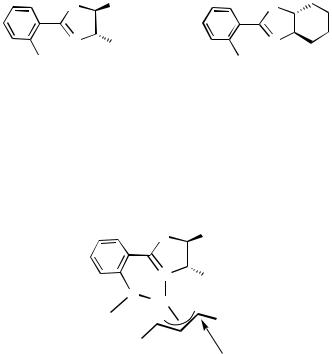
70 |
II PALLADIUM COMPOUNDS: STOICHIOMETRIC PREPARATION |
Asymmetric allylic substitution of 1 with dimethyl malonate was carried out in the presence of [Pd( -allyl)Cl]2 (0.5–2.5 mol %), thioimidazolines 10 or 11 (2–10 mol %), and a mixture of N,O-bis(trimethylsilyl)acetamide (BSA) and a catalytic amount of LiOAc in dichloromethane, affording (S)-2 or (R)-2 with 93 – 96% or 48% ee, respectively (Scheme 6).
|
|
Me |
|
|
|
Me |
||
|
|
|
|
Ph |
|
|
|
|
|
|
N |
|
|
N |
|||
|
|
N |
Ph |
|
|
N |
||
S |
|
Ph |
|
S |
|
Ph |
||
|
|
|
||||||
10 |
|
11 |
||||||
|
|
|
|
|
Scheme 6 |
|||
The reaction probably proceeds through an M-type intermediate 12. Nucleophilic attack occurs predominantly at the allyl terminus trans to the better -acceptor (S N of imidazoline) (Scheme 7).
Me |
|
|
|
|
Ph |
N |
||
N |
Ph |
|
S Pd |
+ |
|
Ph |
Ph |
|
|
|
|
Ph |
|
|
12 |
Nu− |
|
|
||
Scheme 7 |
|
|
B.iii. Imine Ligands
Amino sulfides 13 were inactive, but transformation of the amino function into an imine produced ligands that made good chiral catalysts with palladium, since amine ligands afford palladium complexes of low reactivity compared to ligands containing -accepting donor groups.
Chiral sulfur –imine ligands 14a–g[9], prepared from commercially available (S)-valinol, have been shown to give up to 94% ee in a Pd-catalyzed allylic substitution of 1 (Scheme 8).
The reactions of 1 with dimethyl malonate were carried out in the presence of [Pd( -allyl)Cl]2, 14a–g, BSA, and KOAc, affording (R)-2 with 82–94% ee. The i-propyl group on the backbone of the chelate ring can dictate the chirality at the sulfur center upon coordination.
The allylic substitutions proceed through the intermediate 15a, which is the major diastereomer at equilibrium, affording (R)-2 (Scheme 9).

II.2.4 Pd(0) AND Pd(II) COMPLEXES CONTAINING SULFUR AND SELENIUM LIGANDS |
71 |
||||||||||
|
|
|
|
|
|
|
|
|
a Ar = Ph |
|
|
|
|
|
|
|
|
|
|
|
b |
= p-NO2C6H4 |
|
R1 N |
S |
|
Ph |
|
N |
S |
|
Ph |
c |
= p-MeOC6H4 |
|
|
|
|
d |
= 2,4,6-Me3C6H2 |
|
||||||
|
|
|
|
||||||||
|
|
|
|||||||||
R2 |
|
|
Ar |
|
|
14a−g |
e |
= 9-anthryl |
|
||
13 |
|
|
|
|
f |
= o-ClC6H4 |
|
||||
|
|
|
|
|
|
||||||
|
|
|
|
|
|
|
|
|
g |
= p-ClC6H4 |
|
Scheme 8
Ar |
N |
. . |
|
|
|
Ar |
N |
||||
|
|
|
|
|
|
||||||
|
|
|
|
|
|
||||||
Ph |
|
+ |
|
|
|
|
|
|
|
Ph |
|
Pd |
|
|
|
|
|
Ph |
|
+ |
|
||
|
|
|
|
|
|
|
|||||
|
S |
|
|
|
Pd |
|
|||||
|
|
Ph |
|
|
|
|
|
||||
|
|
|
Ph |
|
|
|
|
|
S |
||
|
|
|
|
|
|
|
|
|
Ph |
||
Nu− |
|
15a |
|
|
|
|
|
|
15b |
||
|
|
|
|
|
Scheme 9 |
|
|
|
|||
. |
. |
|
B.iv. Pyridine Ligands
The sulfur-containing pyridine ligands have been prepared starting from ( )-pinocar- vone.[10] The allylic alkylations of 1 with dimethyl malonate using these ligands 16a,b were carried out in the presence of [Pd( -allyl)Cl]2, BSA, and KOAc, affording (R)- or (S)-2 with 83% or 78% ee, respectively (Scheme 10).
|
N |
Ph |
|
N |
Ph |
|
|
|
|
||
Ph |
S |
|
Ph |
S |
|
|
|
|
|||
|
16a |
|
16b |
|
|
|
|
|
|
||
|
|
|
Scheme 10 |
|
|
B.v. Acetal Ligands
Sulfur-containing chiral acetals derived from C2-symmetric diols have been developed.[11] Ligands 17–20 in which the acetals are tethered to an auxiliary donor atom (sulfur) have afforded (S)-2 with 5%, 60%, 50%, or 82% ee, respectively, in the Pd-catalyzed allylic substitution reactions of 1 with dimethyl malonate using [Pd( -allyl)Cl]2, BSA, and KOAc in dichloromethane at room temperature (Scheme 11).

72 II PALLADIUM COMPOUNDS: STOICHIOMETRIC PREPARATION |
|
|||||||
|
|
O |
|
O |
Me |
|
S |
O |
|
|
|
|
Ph |
||||
|
|
Me |
|
|
|
|||
S |
|
S |
|
Ph |
|
|||
|
|
|
|
|
|
O |
||
|
|
O |
|
O |
|
|
|
|
|
|
|
|
|
|
|
||
|
|
Me |
|
|
Ph |
Ph |
||
|
17 |
|
18 |
19 |
||||
|
|
|
|
|
|
|||
|
|
|
|
|
|
|
|
O |
|
|
|
|
|
|
|
|
|
|
|
|
|
|
|
|
|
|
|
|
|
|
|
|
|
|
Ph |
|
|
|
|
|
|
|
S |
O |
|
|
|
|
|
Ph |
|
||
20 |
Ph |
|
|
Scheme 11 |
|
B.vi. (S)-Proline-Derived Phosphine Ligands
(S)-Proline-derived phosphines bearing various sulfenyl substituents have been developed.[12] Use of 21a– g as chiral ligands provided (S)-2, except 21e [(R)-2], with 31 –88% ee in the Pd-catalyzed allylic alkylation of 1 with dimethyl malonate using [Pd( -allyl)Cl]2, BSA, and AcONa in dichloromethane at room temperature. Increasing the steric bulk of the substituents of the sulfenyl groups results in enhanced enantiocontrol (21g. provides 88% ee). The thiophene ligand 22 provides (R)-2 with 30% ee (Scheme 12).
O
N
SR H
H
 PPh2
PPh2
21a−g
aR = Me
b= Et
c= n-Pr
d= i-Pr
e= Ph
f= PhCH2
CH2
g= 


Scheme 12
O
N
S
H
PPh2
22
Alkylthio groups, except phenylthio and thiophene substituents, coordinate to palladium in the Pd-catalyzed asymmetric allylic alkylation, forming nine-membered chelates
R
O
|
|
N |
|
|
|
|
|
H |
|
S |
|
+ |
P |
Ph |
|
|
|||
|
|
|
||
|
|
Pd |
Ph |
|
: |
1 |
|
3 |
|
|
|
|
|
|
|
Ph |
|
|
Ph |
|
23a |
|
|
|
Scheme 13
:
O |
|
|
|
|
|
N |
|
|
|
|
H |
|
Ph |
|
S |
+ |
P |
||
|
||||
|
|
|||
|
Pd |
Ph |
|
|
R |
1 |
|
||
3 Ph |
||||
Ph |
||||
|
23b |
|
|
|

II.2.4 Pd(0) AND Pd(II) COMPLEXES CONTAINING SULFUR AND SELENIUM LIGANDS |
73 |
of palladium. An M-typed -allylpalladium complex 23a is preferred to a W-typed one 23b and the nucleophile attacks the allyl terminus in 23a trans to the better -acceptor, which is the sulfenyl group at the current case, to furnish (S )-2 (Scheme 13).
C. CHIRAL LIGANDS CONTAINING CHIRAL SULFINYL GROUPS C.i. Chiral Sulfoxide Ligands Bearing Other Chiral Auxiliaries
Chiral sulfinyl functionality can be applied as another coordinating element in ligands in Pd-catalyzed reactions.
Chiral oxazoline ligands 24a,b[13] bearing a chiral sulfinyl group provided enantioselectivity of (S)-2 with 88% or 55% ee, respectively, in the Pd-catalyzed alkylation of 1 with dimethyl malonate using [Pd( -allyl)Cl]2, BSA, and KOAc in dichloromethane at 20 °C.
The usefulness of chirality of sulfoxide as a sole chiral source was demonstrated. Use of chiral sulfoxides 25a,b afforded (S )-2 with 56% and 49% ee, respectively.
A chiral sulfoxide ligand ( )-26[14] bearing a pyridinyl group provided (S)-2 with 34% ee. The stereochemistry of the stereogenic carbon center in ( )-26 was unknown (Scheme 14).
|
|
|
|
|
|
|
|
|
|
|
|
|
|
|
|
|
|
|
|
: |
|
O |
: |
|
O |
|
|
|
|
|
|
|
S |
||
|
S |
|
N |
Pri Tol |
S |
N |
|
|
Tol |
O |
O |
Pri Tol |
|||||
|
|
24a |
|
24b |
25a |
|||
|
|
|
|
|
|
|
|
b |
Scheme 14
: |
|
O |
|
|
N |
R |
|
|
|
||
|
|
||
O |
R |
||
|
|
|
|
R = H |
|
||
|
|
= Me |
|
N |
Pri |
|
: |
||
|
||
|
S |
|
Tol |
O |
|
|
26 |
(S)-Proline-derived phosphines 27a,b[12] bearing chiral sulfinyl groups were used as chiral ligands in Pd-catalyzed allylic alkylations of 1 with dimethyl malonate using [Pd( -allyl)Cl]2, BSA, and AcONa, affording (S)-2 with 60% and 33% ee, respectively (Scheme 15).
O
|
N |
|
: |
|
S |
O |
Et |
|
|
|
27a |
H
PPh2
O
Scheme 15
O
N
Et
S
:
27b
H
PPh2
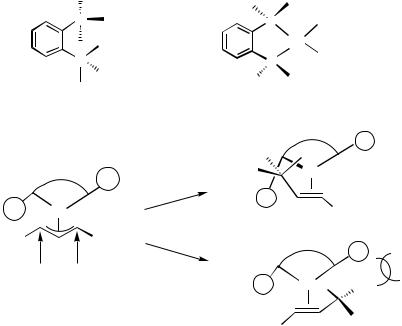
74 |
II PALLADIUM COMPOUNDS: STOICHIOMETRIC PREPARATION |
C.ii. Ligands Bearing Sulfinyl Groups as Sole Chiral Sources
A chiral bis-sulfoxide ligand 28 has been developed as a new ligand bearing a sulfinyl group as a sole chiral source.[15]
The structure of a palladium complex derived from 28 was determined as a C2-sym- metric five-membered chelate 29 by coordination of the sulfinyl sulfur atoms by the X-ray crystallographic analysis. The allylic alkylations of 1 with dimethyl malonate were carried out in dichloromethane at 25 °C in the presence of [Pd( -allyl)Cl]2, (S,S )-28, BSA, and AcONa, affording (S)-2 with 64% ee. The nucleophile attacks the allyl terminus at position A in 30 to avoid the steric interaction between the phenyl group and a large substituent L (Scheme 16).
O
|
|
|
O |
|
S Tol |
S |
|
|
: |
O |
|
|
|
|
|
|
S |
Tol |
S |
|
|
Tol |
|
|
: |
|
|
|
|
|
|
|
(S,S)−28 |
29 |
|
|
|
|
Ph |
|
|
L |
Nu |
|
|
A |
|
|
|
|
|
L |
|
|
L |
Pd |
|
|
|
Ph |
|
Ph |
|
A |
B |
|
B |
|
L |
||
|
|
|
|
|
30 |
|
|
Ph
Scheme 16
Tol
Cl
Pd
Cl
O
|
L |
H |
|
Pd |
|
|
Ph |
|
L |
Pd H |
Ph |
|
Nu |
Chiral -amino sulfoxides served as chiral ligands in Pd-catalyzed allylations.[16],[17] Chiral -aminoethyl sulfoxides 31a–f-palladium complexes catalyzed asymmetric allylations of 33 to give (S)-34 with 29% ee. o-Aminophenyl sulfoxides 32a,b provided much higher enantioselectivity (50%), presumably due to the sterically fixed structure of the intermediary palladium complex 35 (Scheme 17).
A new chiral o-(phosphinoamino)phenyl sulfoxide has been demonstrated as an efficient ligand in the Pd-catalyzed asymmetric allylic alkylations of 1 with dimethyl sodiomalonate using [Pd( -allyl)Cl]2, affording (S)-2 [45% ee with (S)-36a].[18]
In particular, (R)-o-(phosphinoamino)phenyl 2-methoxy-1-naphthyl sulfoxide (36b) provides the highest enantioselectivity (97%) of (R)-2 among the known ligands bearing a chiral organosulfur group as a sole chiral source.
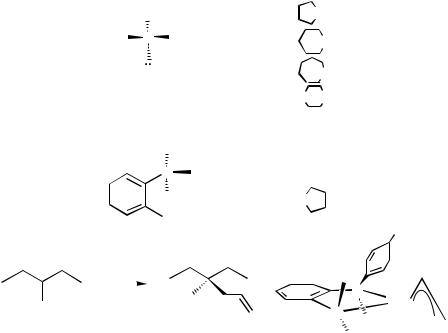
II.2.4 |
Pd(0) AND Pd(II) COMPLEXES CONTAINING SULFUR AND SELENIUM LIGANDS 75 |
|||||||||||||||||||||
|
|
|
|
|
|
|
|
O |
|
|
|
|
|
|
a R2N = |
N |
|
|
|
|
||
|
|
|
R2NCH2CH2 |
|
S |
Tol |
|
|
|
b |
= |
N |
|
|
|
|
||||||
|
|
|
|
|
|
|
|
|
|
|
|
|
|
|
|
|
|
|
|
|
|
|
|
|
|
|
|
31a−f |
|
|
|
|
|
|
|
|
c |
= |
N |
|
|
|
|
||
|
|
|
|
|
|
|
|
|
|
|
|
|
|
|
|
|
|
|
|
|||
|
|
|
|
|
|
|
|
|
|
|
|
|
|
|
d |
= O |
N |
|
|
|
|
|
|
|
|
|
|
|
|
|
|
|
|
|
|
|
|
e |
= c-Hex(Me)N |
|
|
|
|
||
|
|
|
|
|
|
|
|
|
|
|
|
|
|
|
f |
= n-Bu(Me)N |
|
|
|
|
||
|
|
|
|
|
|
|
|
O |
|
|
|
|
|
|
|
|
|
|
|
|
|
|
|
|
|
|
|
|
|
|
S |
|
|
Tol |
a R2N = NMe2 |
|
|
|
|
||||||
|
|
|
|
|
|
|
|
|
|
|
|
|
|
|
|
|
|
|
||||
|
|
|
|
|
|
|
: |
|
|
|
|
|
|
b |
= N |
|
|
|
|
|
||
|
|
|
|
|
|
|
|
NR2 |
|
|
|
|
|
Me |
||||||||
|
|
|
|
|
|
|
|
|
|
|
|
|
||||||||||
|
|
|
|
|
|
|
|
|
|
|
|
|
|
|
|
|||||||
|
|
|
|
|
|
|
32a,b |
|
|
|
|
|
|
|
|
|
|
|
||||
|
|
|
|
|
|
|
O |
O |
|
|
|
|
|
|
|
|
||||||
O |
O |
|
Me |
OBut |
|
|
R |
|
|
|
|
|||||||||||
|
|
|
|
|
|
|
||||||||||||||||
|
|
|
|
|
OBut |
|
|
|
|
|
|
|
|
|
|
|
|
|
|
|||
|
|
|
|
|
|
|
|
|
|
|
|
|
|
|
|
|
|
|
||||
Me |
|
|
|
|
|
|
|
|
|
|
|
|
|
|
|
|
||||||
|
|
|
|
Me |
|
|
|
|
|
S |
+ |
|
|
|||||||||
|
|
|
|
|
|
|
|
|
|
|
|
|||||||||||
|
|
|
|
|
|
|
|
|
|
|
|
|
|
|
|
|
||||||
|
|
|
|
|
|
|
|
|
|
|
|
|
|
|
|
|
|
|||||
|
|
|
Me |
|
|
|
|
|
|
|
|
|
|
|
N |
|
Pd |
|
|
|||
|
|
|
|
|
|
|
|
|
|
|
|
|
|
|
|
|||||||
|
|
|
|
|
|
|
|
|
|
|
|
|
|
O |
||||||||
|
|
|
|
|
|
|
|
|
|
|
|
|
|
|
|
|
|
|||||
|
|
|
33 |
|
|
|
|
|
|
|
|
(S)-34 |
|
|
|
|
||||||
|
|
|
|
|
|
|
|
|
|
|
|
|
|
R |
|
|
|
|
||||
|
|
|
|
|
|
|
|
|
|
|
|
|
|
|
|
|
|
|
|
|
|
|
|
|
|
|
|
|
|
|
|
|
|
|
|
|
|
|
|
|
35 |
|
|
|
|
Scheme 17
Since the steric crowd by the large naphthyl group disturbs the alkylation at the allylic site trans to the phosphorus group in the sterically preferred 37a in the equilibrium of 37a,b, the preferential alkylation at the allylic site syn to the phosphorus group in 37a gave (R)-2 (Scheme 18).
The first attempt to use chiral -phosphino sulfoxides as chiral ligands was successfully accomplished in Pd-catalyzed asymmetric allylic alkylations and aminations.[19]
Chiral -phosphinoethyl p-tolyl sulfoxide (38) undergoes a rapid internal redox reaction between the sulfinyl and the phosphino group. On the other hand, an aromatic phosphino sulfoxide is much more stable; a chiral sulfoxide 39a is recovered without any racemization even though at a much higher temperature (130–140 °C).
2-Methoxy-1-naphthyl sulfoxide 39b is stable in THF at room temperature; however, it undergoes a gradual internal redox reaction in THF at reflux, generating the corresponding phosphine oxide, presumably due to the stereoelectronic effect of the 2-methoxy-1- naphthyl substituent (Scheme 19).
The Pd-catalyzed allylic alkylation or amination of 1 with dimethyl sodiomalonate or benzylamine using [Pd( -allyl)Cl]2 provided (S)-2 or (R)-40 with 82% or 85% ee, respectively.
The structure of a palladium complex derived from 39b and PdCl2 was determined as a five-membered chelate 41 coordinated by the sulfinyl sulfur and phosphorus groups by X-ray crystallographic analysis.
In the conformational equilibrium of the five-membered chelated -allylpalladium complex, a conformer 42b is preferred to 42a by the steric reason. The nucleophile
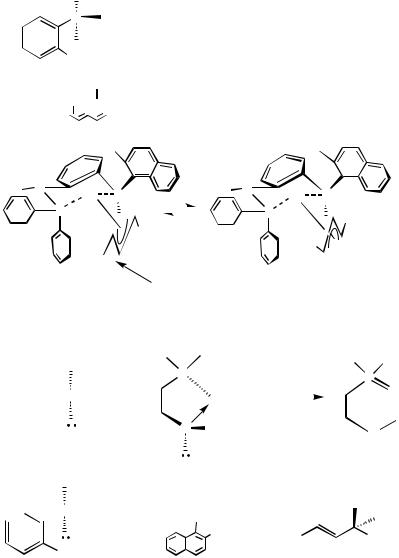
76 |
II PALLADIUM COMPOUNDS: STOICHIOMETRIC PREPARATION |
||
|
|
O |
|
|
|
S |
R |
|
|
|
|
|
|
: |
|
NHPPh2
(S)-36a R = p-MeC6H4
(R)-36b = 

 OMe
OMe
MeO
H |
N |
+ |
|
|
Pd S |
||
|
|
|
|
|
|
P |
|
|
|
|
O |
|
|
|
|
|
|
|
Ph |
|
|
|
|
|
|
|
|
|
|
|
37a |
O
Ph2PCH2CH2 S
S p-Tol
p-Tol
38
O

 S
S Ar
Ar
PPh2
39a,b
|
|
|
|
|
|
|
|
|
|
MeO |
|
|
|
|
|
|
|
|
|
|
|
H |
N |
|
+ |
|
|
|
|
|
|
|
|
|
|
|
|
|
|
|
|
|
|
||||
|
|
|
|
|
|
|
|
Pd S |
|
|
|
|
|||
|
|
|
|
|
|
|
|
|
|
|
|
|
|
||
|
|
|
|
|
|
|
|
|
P |
|
O |
|
Ph |
|
|
|
|
|
|
|
|
|
|
|
|
|
|
||||
|
|
|
|
|
|
|
|
|
|
|
|
|
|||
Ph |
|
|
|
|
|
|
|
|
|
|
|
||||
|
|
|
|
|
|
Ph |
|
|
|
|
|||||
|
|
|
|
|
|
|
|
|
|
|
|
|
|
||
Nu− |
|
|
|
|
|
|
37b |
|
|
|
|
||||
|
|
|
|
|
|
|
|
|
|
||||||
|
|
|
|
|
|
|
|
|
|
|
|
||||
|
Scheme 18 |
|
|
|
|
|
|
|
|
||||||
Ph |
Ph |
|
|
|
|
Ph |
Ph |
||||||||
|
|
|
|
|
|
|
|
|
|
|
|
||||
|
|
P |
|
|
|
|
|
|
|
|
|
|
|
P |
|
|
|
|
|
|
|
|
|
|
|
|
|
|
|
|
|
|
|
|
|
|
O |
|
|
|
|
|
|
|
O |
||
|
|
S |
|
|
|
|
|
|
|
|
Tol |
||||
|
|
p-Tol |
|
|
|
|
|
|
|
||||||
|
|
|
|
|
|
|
|
|
S |
||||||
|
|
|
|
|
|
|
|
|
|
|
|
|
|
|
|
Ar = p-Tol |
|
NHCH2Ph |
|
|
H |
||
= |
OMe |
Ph |
Ph |
|
|||
|
|||
|
|
|
(R)-40 |
Scheme 19 |
|
|
|
attacks preferentially the allyl terminus in 42b trans to the better -acceptor, which is the phosphine group in the present case, despite the steric effect by the bulky substituent (Scheme 20).
A chiral sulfoxide–palladium complex was determined as a chelate coordinated by the sulfinyl oxygen atom by X-ray crystallographic analysis.[20] The amino-phosphine palladium chloride 43 was transformed into 44 by chloride abstraction with AgPF6. The six-membered P—O chelate structure was confirmed by crystallographic analysis (Scheme 21).
